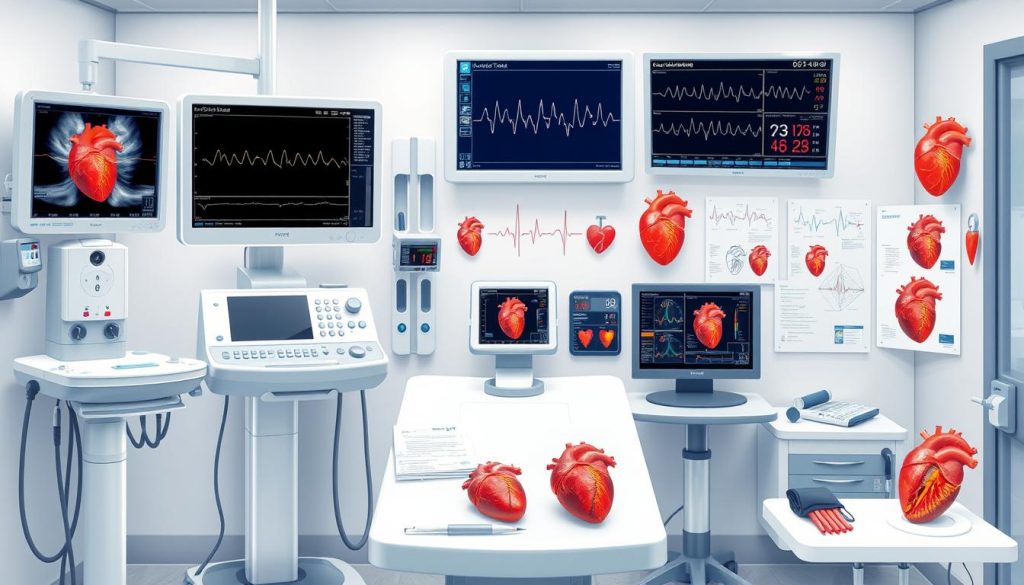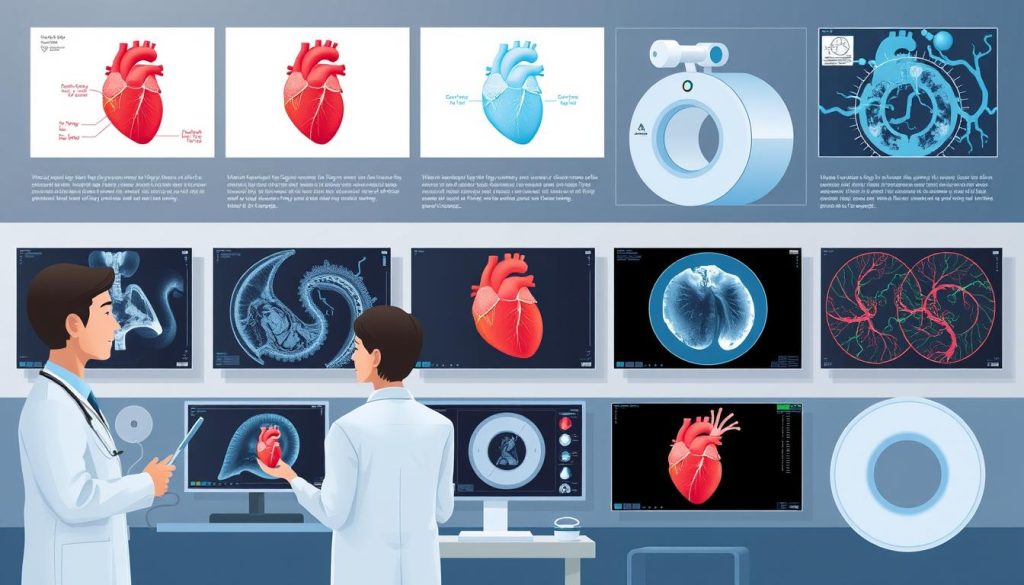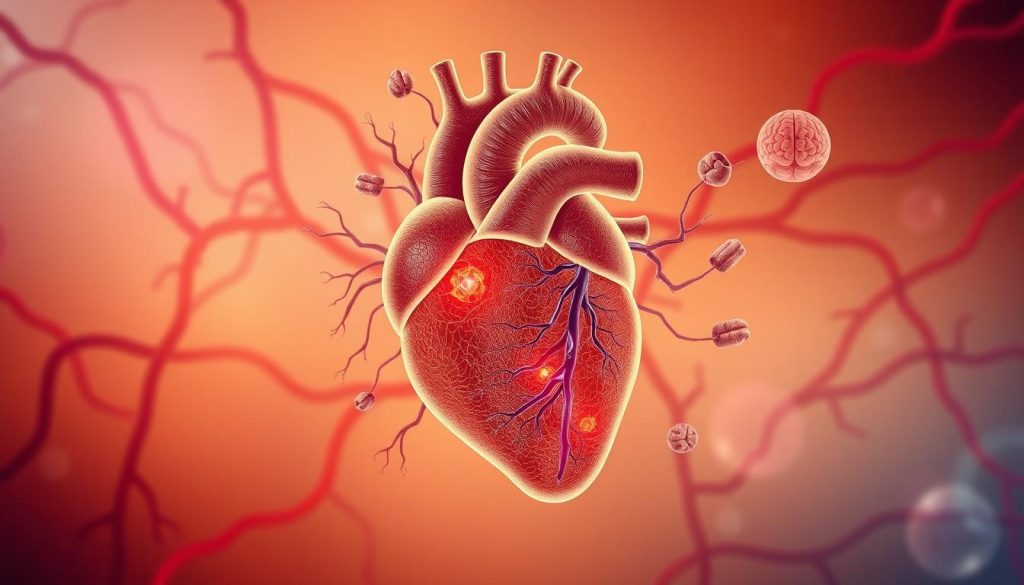Heart health is a big concern for many Americans. Knowing how to spot cardiovascular disease can save lives. This guide will look at how doctors find heart problems and the signs you should look out for.
We’ll cover everything from common symptoms to advanced screening methods. Early detection is critical in treating heart conditions. Let’s explore how doctors find heart issues.
Understanding Common Signs and Symptoms of Heart Disease
It’s important to know the signs of heart disease early. Heart problems can show up in many ways. This makes checking your heart health key for everyone.
Physical Symptoms and Warning Signs
Physical symptoms often start the process of finding heart problems. Chest pain is a big sign, but there are others. Shortness of breath, even when you’re not doing much, can be a warning.
Feeling very tired, swelling in your legs, and irregular heartbeats are also signs. These can mean you might have heart trouble.
Emotional and Mental Health Indicators
Heart disease affects more than just your body. Emotional and mental symptoms can be signs too. Feeling anxious, depressed, or having mood swings might be related to heart health.
Stress and trouble sleeping can also hurt your heart. These signs are important to notice.
Gender-Specific Symptom Variations
Men and women show heart disease symptoms differently. Men often get the classic chest pain. But women might feel nausea, jaw pain, or extreme tiredness instead.
Knowing these differences helps in checking your heart health right.
| Symptom | Men | Women |
|---|---|---|
| Chest Pain | Common, often intense | Less common, may be mild |
| Fatigue | Sometimes present | Often severe and unexplained |
| Nausea | Rare | More common |
| Jaw Pain | Uncommon | More frequent |
It’s vital to recognize these different symptoms. If you notice any, see a doctor for a detailed heart check.
How Do You Diagnose Cardiovascular Disease: A Complete Guide
Diagnosing heart disease needs a detailed plan. Doctors use many tests to check the heart’s health. This careful process helps find problems early and plan the right treatment.

The first step is talking about your health history. Doctors ask about your symptoms, family health, and lifestyle. This helps them understand your risk and decide what tests to do next.
Physical exams are also key. Doctors listen to your heart, check your blood pressure, and look at your overall health. These simple steps can show signs of heart issues.
Modern tests are the heart of diagnosing heart disease. These include:
- Electrocardiograms (ECG) to record heart electrical activity
- Echocardiograms for detailed heart structure imaging
- Stress tests to evaluate heart function during exercise
- Blood tests to check cholesterol levels and other markers
Sometimes, doctors need to do more detailed tests like cardiac catheterization. These tests give detailed info about the heart’s function and blood flow.
| Diagnostic Procedure | Purpose | Invasiveness |
|---|---|---|
| ECG | Record heart electrical activity | Non-invasive |
| Echocardiogram | Image heart structure | Non-invasive |
| Stress Test | Evaluate heart function during exercise | Minimally invasive |
| Cardiac Catheterization | Assess blood flow and heart function | Invasive |
By using all these methods, doctors can accurately find heart disease. They then create a treatment plan just for you. This thorough approach makes sure every aspect of heart health is checked.
Initial Medical Assessment and Physical Examination
The first step in finding heart problems is a detailed medical check-up. This step combines several important parts to check the heart’s health and find any heart issues.
Medical History Evaluation
Doctors begin by asking for a detailed medical history. They ask about symptoms, lifestyle, and family health. This helps understand your heart health and risk factors.
Vital Signs Monitoring
Checking vital signs is key for heart health. These signs give clues about how well your heart works.
| Vital Sign | Normal Range | Significance |
|---|---|---|
| Blood Pressure | 120/80 mmHg | Indicates arterial health |
| Heart Rate | 60-100 bpm | Shows heart’s efficiency |
| Respiratory Rate | 12-20 breaths/min | Reflects lung-heart interaction |
Physical Heart Examination Techniques
The physical exam uses special techniques to check the heart. Doctors listen with stethoscopes for unusual heart sounds. They also check for swelling in the legs or neck veins, which can show heart problems.
These first steps in diagnosing heart disease offer important insights. They help doctors decide if more tests are needed and create a heart health plan.
Advanced Cardiac Diagnostic Testing Methods
Doctors use advanced tests to find heart problems. These tests show how well the heart is working. They help doctors decide the best treatment.
Non-Invasive Testing Procedures
Non-invasive tests are painless and don’t hurt. They include:
- Electrocardiogram (ECG)
- Stress tests
- Holter monitors
These tests track the heart’s activity. They help find issues with heart rhythm or blood flow.
Invasive Diagnostic Techniques
Some tests need direct access to the heart. Invasive procedures are:
- Cardiac catheterization
- Electrophysiology studies

Emerging Diagnostic Technologies
New tech is changing heart disease diagnosis. New tools include:
- 3D printing of heart models
- Artificial intelligence for image analysis
- Wearable devices for continuous monitoring
These innovations offer more accurate and personal tests. They help doctors find problems sooner and tailor treatments.
Blood Tests and Laboratory Analysis for Heart Health
Blood tests are key in checking heart health and finding heart disease risk. They look at different biomarkers and lipid profiles to understand your heart’s condition.

- Lipid profile (cholesterol levels)
- C-reactive protein (CRP)
- Troponin
- B-type natriuretic peptide (BNP)
- Hemoglobin A1C
Your doctor might order these tests for routine checks or if you show heart disease symptoms. The results help spot risks and guide treatment plans.
| Test | Purpose | Normal Range |
|---|---|---|
| Total Cholesterol | Assessing heart disease risk | Less than 200 mg/dL |
| LDL Cholesterol | Evaluating plaque buildup risk | Less than 100 mg/dL |
| HDL Cholesterol | Measuring “good” cholesterol | 60 mg/dL or higher |
| Triglycerides | Assessing fat levels in blood | Less than 150 mg/dL |
Regular blood tests are vital for keeping an eye on heart health and catching problems early. By being proactive with heart screenings, you can help keep your heart healthy and lower heart disease risk.
Imaging Technologies in Cardiovascular Diagnosis
Cardiovascular diagnostic procedures have made huge strides. They give doctors tools to spot heart issues. These imaging technologies show the heart’s structure and how it works. This helps doctors diagnose and plan treatments accurately.
Echocardiography and Ultrasound
Echocardiography uses sound waves to show the heart in real-time. It’s a non-invasive method. Doctors can check heart valves, blood flow, and structure. Early detection through echocardiography can lead to better treatment outcomes.
CT and MRI Scanning
Computed Tomography (CT) and Magnetic Resonance Imaging (MRI) scans give detailed views of the heart. They are great at showing:
- Coronary artery blockages
- Heart muscle damage
- Structural abnormalities
CT scans are good at finding calcium in arteries. MRIs show soft tissues better.

Nuclear Medicine Imaging
Nuclear imaging uses radioactive tracers in the bloodstream. It helps check:
- Blood flow to the heart muscle
- Pumping function
- Presence of damaged heart tissue
Tests like myocardial perfusion scans and positron emission tomography (PET) scans are common.
| Imaging Technology | Key Benefits | Limitations |
|---|---|---|
| Echocardiography | Real-time imaging, non-invasive | Limited view of some structures |
| CT Scan | Detailed views of arteries, fast | Radiation exposure |
| MRI | Excellent soft tissue contrast | Time-consuming, not for all patients |
| Nuclear Imaging | Assesses blood flow and function | Involves radioactive tracers |
Risk Factor Assessment and Prevention Strategies
Knowing your risk for heart disease is key to staying healthy. To understand your risk, doctors look at many factors. These include your genes, family history, and lifestyle choices.
Genetic and Family History Analysis
Your genes are important for heart health. If your family has heart disease, you might be at higher risk. Doctors check your family history to find genetic risks.
Lifestyle Risk Evaluation
What you do every day affects your heart. Smoking, bad diet, not exercising, and too much alcohol increase risk. Doctors look at these habits to make a plan to help you.

Preventive Screening Programs
Regular heart screenings are vital for catching problems early. These include blood pressure, cholesterol, and blood sugar tests. Finding risks early lets you make changes to stay healthy.
| Screening Test | Frequency | Purpose |
|---|---|---|
| Blood Pressure Check | Annually | Detect hypertension |
| Cholesterol Test | Every 4-6 years | Assess lipid levels |
| Blood Sugar Test | Every 3 years | Screen for diabetes |
Doctors use genetics, lifestyle checks, and screenings to lower heart disease risk. Early detection and prevention are essential for a healthy heart.
Understanding Diagnostic Results and Treatment Planning
After your heart health check, your doctor will share the findings. This is key to figuring out any heart problems and planning your care. They might use charts or models to explain your heart’s condition. They’ll talk about any issues found and how they affect your health.
Together, you and your healthcare team will make a treatment plan just for you. This plan could include lifestyle changes, medicines, or procedures to boost your heart health. It’s important to be involved – ask questions and share your thoughts. Managing heart health is a team effort between you and your doctors.
Learning about heart disease is also important. Your doctor might suggest cardiac rehabilitation programs to teach you about heart-healthy living. These programs cover diet, exercise, and managing stress. Knowing about your condition and treatment options helps you make better choices for your heart.
Regular check-ups are vital to track your progress and adjust your treatment if needed. Your doctor will schedule follow-ups to see if your heart health is getting better. Stay committed to your plan and don’t hesitate to ask questions or concerns between visits. Your active role can greatly improve your heart health.
FAQ
Q: What are the most common symptoms of cardiovascular disease?
A: Common symptoms include chest pain or discomfort, shortness of breath, and irregular heartbeat. Fatigue and swelling in the legs are also signs. Some people might feel nausea, jaw pain, or cold sweats.
Q: How do doctors initially assess for heart disease?
A: Doctors start with a detailed medical history and check vital signs like blood pressure. They listen to your heart with a stethoscope. This helps decide if more tests are needed.
Q: What non-invasive tests are used to diagnose cardiovascular disease?
A: Tests include electrocardiograms (ECGs) and echocardiograms to see the heart’s structure. Stress tests and CT or MRI scans are also used. These tests are safe and provide important information.
Q: Are blood tests important in diagnosing heart conditions?
A: Yes, blood tests are key in diagnosing heart conditions. They check cholesterol levels and proteins that show heart damage. Tests like hs-CRP help check inflammation levels.
Q: What is cardiac catheterization and when is it necessary?
A: Cardiac catheterization involves inserting a thin tube into a blood vessel. It’s used to diagnose heart problems. It’s needed when non-invasive tests don’t give enough information.
Q: How does family history affect cardiovascular disease diagnosis?
A: Family history is important in assessing heart disease risk. Early heart disease in relatives increases your risk. Doctors use this information to plan screenings and prevention strategies.
Q: What lifestyle factors are evaluated when assessing heart disease risk?
A: Doctors look at your diet, exercise, smoking, alcohol use, stress, and sleep. These factors greatly affect heart health. Changing these habits can help prevent heart disease.
Q: How often should I get screened for cardiovascular disease?
A: Screening frequency depends on your age, risk factors, and health. Adults should have blood pressure checked yearly and cholesterol tested every 4-6 years. More frequent tests may be needed based on your risk factors.
Q: What emerging technologies are being used in cardiovascular diagnostics?
A: New technologies include 3D echocardiography and cardiac MRI with AI. Wearable devices and genetic testing are also being used. These advancements help diagnose and treat heart conditions more accurately.
Q: How do I interpret my cardiovascular diagnostic test results?
A: Understanding test results is complex and should be done with your doctor. They’ll explain what your results mean for your health. Ask questions about your results and what they mean for your heart health.


















